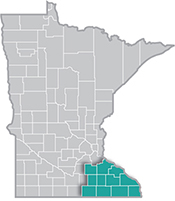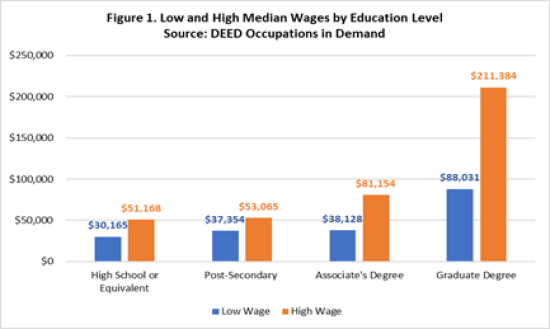 Southeast Minnesota is a health care and agricultural powerhouse. The region is home to the renowned Mayo Clinic and some of the world's most recognized food companies and brands.
Southeast Minnesota is a health care and agricultural powerhouse. The region is home to the renowned Mayo Clinic and some of the world's most recognized food companies and brands.
Advanced manufacturing is especially strong here, with machinery, chemicals, and electronics among the top products.
Want the freshest data delivered by email? Subscribe to our regional newsletters.
12/27/2021 9:00:00 AM
It's no surprise that jobs in health care are in high demand in Southeast Minnesota given that over one-quarter of the jobs in the region are in the Health Care & Social Assistance industry. According to DEED's Quarterly Census of Employment and Wages data for the second quarter of 2021, there were just under 1,800 Health Care & Social Assistance establishments providing 66,228 jobs in the 11-county region, dwarfing the next largest employing industry, which is Manufacturing with 35,721 jobs.
In fact, among the top 100 Occupations in Demand in Southeast, 24 of the occupations on the list are in health care, including four in the top 10, with Registered Nurses being number one. In addition, all of these 24 health care occupations have a 5-star demand indicator, which is the highest level of occupational demand (see Table 1).
Table 1. In-Demand Health Care Occupations in Top 100 - Southeast Minnesota
| Job Title | Current Demand Rank | Current Demand Indicator | Median Annual Wage | Projected 10-year Growth Rate | Education Requirements | Training Requirements |
|---|---|---|---|---|---|---|
| Registered Nurses | 1 | ««««« | $81,154 | 12.4% | Associate's | Short-Term |
| Home Health and Personal Care Aides | 2 | ««««« | $30,165 | NA | H.S. or Equiv. | Unavailable |
| Nursing Assistants | 6 | ««««« | $37,354 | NA | Postsecondary | Short-Term |
| Licensed Practical and Licensed Vocational Nurses | 10 | ««««« | $50,331 | 12.8% | Postsecondary | Short-Term |
| Pharmacy Technicians | 15 | ««««« | $39,679 | 7.2% | H.S. or Equiv. | Short-Term |
| Medical Assistants | 19 | ««««« | $45,237 | 21.0% | Postsecondary | Short-Term |
| Family Medicine Physicians | 26 | ««««« | NA | NA | Graduate | Short-Term |
| Medical Secretaries and Administrative Assistants | 34 | ««««« | $43,461 | 14.2% | H.S. or Equiv. | Short-Term |
| Nurse Practitioners | 39 | ««««« | $123,312 | 22.8% | Graduate | Short-Term |
| Radiologic Technologists and Technicians | 44 | ««««« | $71,645 | 13.3% | Associate's | Unavailable |
| Surgical Technologists | 48 | ««««« | $62,503 | 12.5% | Associate's | Short-Term |
| Veterinary Technologists and Technicians | 49 | ««««« | $38,128 | 19.0% | Associate's | Short-Term |
| Emergency Medical Technicians and Paramedics | 50 | ««««« | $41,658 | NA | Postsecondary | Unavailable |
| Medical and Health Services Managers | 54 | ««««« | $102,712 | 17.0% | Bachelor's | Short-Term |
| Physician Assistants | 60 | ««««« | $125,894 | 28.4% | Graduate | Short-Term |
| Nurse Anesthetists | 69 | ««««« | $211,384 | 18.9% | Graduate | Short-Term |
| Pharmacists | 72 | ««««« | $139,872 | 2.7% | Graduate | Short-Term |
| Phlebotomists | 74 | ««««« | $40,586 | 27.0% | H.S. or Equiv. | Short-Term |
| General Internal Medicine Physicians | 75 | ««««« | NA | NA | Graduate | Short-Term |
| Cardiovascular Technologists and Technicians | 78 | ««««« | $68,512 | 11.8% | Associate's | Short-Term |
| Clinical Laboratory Technologists and Technicians | 79 | ««««« | $57,218 | 12.1% | Associate's | Unavailable |
| Ophthalmic Medical Technicians | 80 | ««««« | $51,168 | 12.8% | H.S. or Equiv. | Short-Term |
| Physical Therapists | 85 | ««««« | $88,031 | 18.4% | Graduate | Short-Term |
| Medical Dosimetrists, Medical Records Specialists, and Health Technologists and Technicians, All Other | 91 | ««««« | $53,065 | NA | Postsecondary | Unavailable |
| Source: DEED Occupations in Demand | ||||||
 Most of these in-demand health care occupations require education beyond high school, with only five on the list – Home Health & Personal Care Aides, Pharmacy Technicians, Medical Secretaries & Administrative Assistants, Phlebotomists, and Ophthalmic Medical Technicians – requiring a high school diploma or equivalent to get started, although some training would be needed to be employed in any of these five occupations.
Most of these in-demand health care occupations require education beyond high school, with only five on the list – Home Health & Personal Care Aides, Pharmacy Technicians, Medical Secretaries & Administrative Assistants, Phlebotomists, and Ophthalmic Medical Technicians – requiring a high school diploma or equivalent to get started, although some training would be needed to be employed in any of these five occupations.
Median annual wages of the health care occupations in the top 100 range from just over $30,000 for Home Health & Personal Care Aides to over $210,000 for Nurse Anesthetists. In general, the data shows that occupations in health care that require higher education levels, such as a graduate or professional degree, are also those that are higher paying. For example, median wage ranges for the occupations that require a high school diploma or equivalent range from $30,165 to $51,168, whereas with a graduate degree the median wages range from $88,031 to $211,384 (see Figure 1).
Undoubtedly, there is going to be strong demand for health care occupations in the future as well. Projections data from DEED shows that Healthcare Practitioners & Technical occupations are slated to grow by 11.4% from 2018 to 2028, with 3,725 new jobs and over 8,500 openings due to labor force exits. In addition, Healthcare Support occupations are projected to increase 9.6%, with over 1,000 new jobs and over 5,600 labor force exit vacancies.
While employment projection data was not available for all of the health care occupations in the top 100 in-demand list, the data that is available shows that all of the occupations are projected to grow, with the highest growth rates seen for Physician Assistants (+28.4%), Phlebotomists (+27%), Nurse Practitioners (+22.8%) and Medical Assistants (+21%). All of these occupations are also expected to see more openings due to labor force exits, such as retirements, with the largest number of exit openings appearing for Registered Nurses (3,820) followed by Nursing Assistants (2,464).
Health care employers in the region are looking to recruit new workers now and into the future. With a wide variety of openings that offer high wages and varying levels of education and training requirements, there are thousands of opportunities for students and jobseekers to get on a health care career path.
To learn more about Health Care Month in Minnesota, visit careerforcemn.com/HealthCare. This page includes resources for job seekers, students and educators and employers. For example, numerous hiring events and career fairs are happening throughout the month of January for those looking for work in the health care industry. Employers can also find additional resources for attracting, developing, and retaining talent online here.
Contact Mark Schultz.